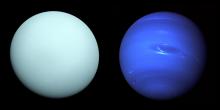Listen to today's episode of StarDate on the web the same day it airs in high-quality streaming audio without any extra ads or announcements. Choose a $8 one-month pass, or listen every day for a year for just $30.
You are here
More Neptune Opposition
Historically, mid-September is the peak of hurricane season here in North America. The most powerful storms generate sustained winds of more than 150 miles per hour, with stronger gusts — strong enough to flatten anything in their path. Yet that’s like a soft spring breeze compared to the winds of Neptune, the Sun’s most remote major planet. Winds there can reach almost 1300 miles per hour.
Neptune is about four times the diameter of Earth. It has a thick atmosphere that’s bright blue. Cold clouds form bright white bands high in the sky.
By tracking the clouds, scientists have measured sustained wind speeds of up to 700 miles per hour. And some gusts are almost twice that speed.
Just what drives the winds isn’t well understood. The planet’s weather is powered mainly by heat coming from inside Neptune. But there’s no clear indication of why the giant planet would have such high-speed winds.
James Webb Space Telescope has found one other interesting feature in the atmosphere — a band of warmer air at the equator. Global circulation patterns may move the atmosphere toward the equator, where it sinks and heats up — creating a hot “girdle” around this giant planet.
Neptune lines up opposite the Sun in our sky this week. It rises at sunset, in the constellation Pisces, remains in view all night, and shines at its brightest. It’s so far away, though, that you need binoculars or a telescope to see it.
Script by Damond Benningfield






